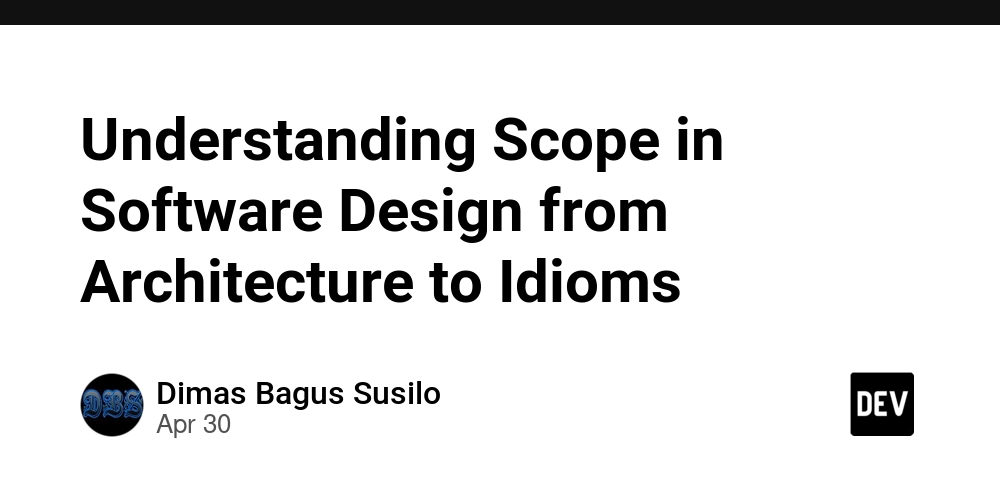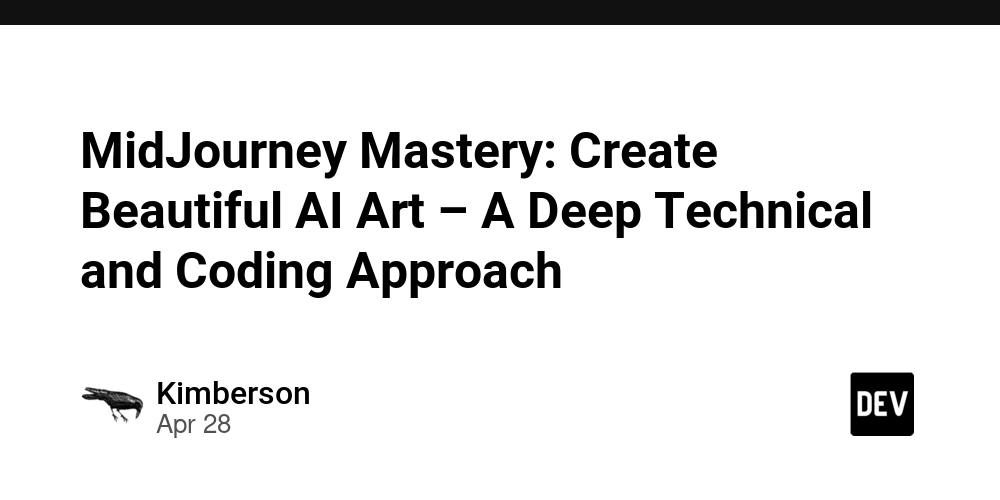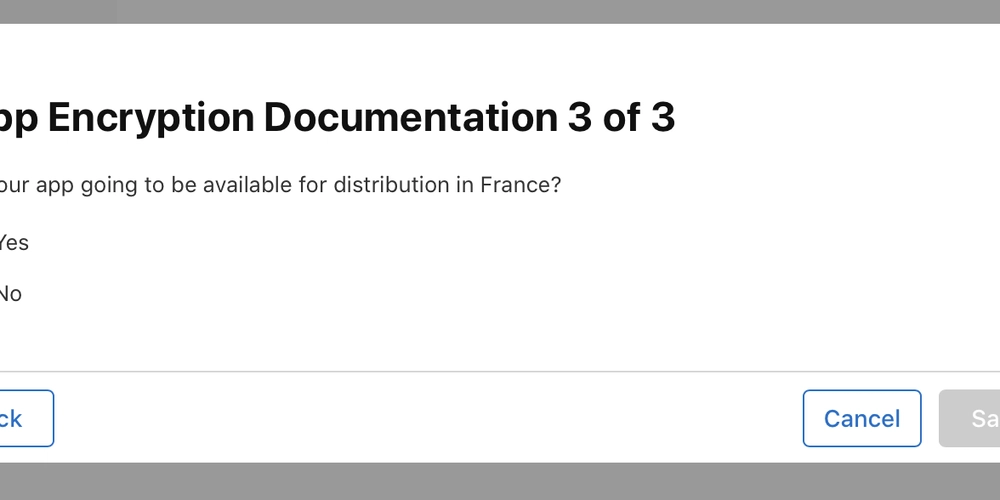Understanding Scope in Software Design from Architecture to Idioms
Software development is filled with terminology that can sometimes feel overlapping or confusing. We talk about "architecture," "design patterns," and "best practices," but what do these terms really mean, and how do they relate to each other? Understanding the different scopes or levels at which we make design decisions is crucial for building robust, maintainable, and scalable software, and for communicating effectively within development teams. Think of software design not as a single activity, but as a series of decisions made at different levels of abstraction, ranging from the highest-level system structure down to the specifics of individual lines of code. Let's break down these common layers. 1. Architectural Styles / Patterns: The System's Blueprint (Highest Level) Scope & Purpose: Operating at the broadest scope, Architectural Styles and Patterns define the fundamental structure, constraints, and principles for the entire system or a major subsystem. They are the "blueprint" that dictates how the largest pieces fit together and interact. Focus: High-level component decomposition (e.g., services, layers), communication mechanisms (synchronous/asynchronous), data flow, distribution strategies, and often, the core technology choices. Decisions made here have significant, long-lasting impact and address system-wide qualities like scalability, resilience, and deployability. Changing the core architecture later is typically very difficult and expensive. Examples: Microservices Layered (N-Tier) Architecture Client-Server Event-Driven Architecture Monolithic Architecture Pipe-and-Filter MVC/MVP/MVVM (when applied as the primary application structure) 2. Architectural Tactics: Achieving Quality Goals Scope & Purpose: While architectural patterns define the overall structure, Architectural Tactics are specific techniques or design decisions employed within that structure to achieve specific quality attributes (non-functional requirements). They are the tools used to ensure the architecture delivers on goals like performance, security, or reliability. Focus: Implementing concrete strategies to address specific quality concerns. A single tactic might contribute to fulfilling the requirements of the chosen architectural style. Examples: For Performance: Caching, Load Balancing, Data Replication. For Availability: Redundancy, Failover Mechanisms, Heartbeating. For Security: Authentication/Authorization patterns, Input Validation strategies, Encryption. For Modifiability: Using Interfaces, Service Locators, Dependency Injection frameworks. 3. Design Patterns: Solving Recurring Problems (Mid-Level) Scope & Purpose: Moving down a level, Design Patterns offer reusable, proven solutions to common problems encountered during the detailed design phase within components or subsystems defined by the architecture. They focus on the relationships and interactions between a few classes or objects. Focus: Enhancing flexibility, reusability, and maintainability at a more granular, localized level. They deal with object creation, structure, and behavior/communication. The famous "Gang of Four" (GoF) patterns fall squarely into this category. Examples: Creational: Singleton, Factory Method, Abstract Factory, Builder. Structural: Adapter, Decorator, Facade, Proxy, Composite. Behavioral: Observer, Strategy, Command, Iterator, Template Method, State. 4. Idioms / Coding Practices: Crafting the Code (Lowest Level) Scope & Purpose: This is the most specific level, often dealing with just a single method or a few lines of code. Idioms and Coding Practices represent the standard, conventional, or most effective way to implement a very specific task or structure within a particular programming language or framework. Focus: Leveraging language features effectively, ensuring clarity, using standard libraries correctly, and adhering to established conventions for writing clean, maintainable, and sometimes performant code snippets. Examples: RAII (Resource Acquisition Is Initialization) in C++. try-with-resources in Java or using in C#. List comprehensions in Python. Standard naming conventions (camelCase/PascalCase). Avoiding "magic strings/numbers." Correctly implementing fundamental methods like equals()/hashCode(). Connecting the Layers It's crucial to see how these levels interact. An architectural style (like Microservices) sets the stage. Within that architecture, tactics (like using load balancers for performance or asynchronous messaging for resilience) are applied. When building the individual services (components), developers use design patterns (like the Factory pattern for creating objects or the Adapter pattern to integrate with a legacy system) to structure the code effectively. Finally, the actual implementation of those patterns and business logic relies on language-specific idioms and coding practices to en

Software development is filled with terminology that can sometimes feel overlapping or confusing. We talk about "architecture," "design patterns," and "best practices," but what do these terms really mean, and how do they relate to each other? Understanding the different scopes or levels at which we make design decisions is crucial for building robust, maintainable, and scalable software, and for communicating effectively within development teams.
Think of software design not as a single activity, but as a series of decisions made at different levels of abstraction, ranging from the highest-level system structure down to the specifics of individual lines of code. Let's break down these common layers.
1. Architectural Styles / Patterns: The System's Blueprint (Highest Level)
- Scope & Purpose: Operating at the broadest scope, Architectural Styles and Patterns define the fundamental structure, constraints, and principles for the entire system or a major subsystem. They are the "blueprint" that dictates how the largest pieces fit together and interact.
- Focus: High-level component decomposition (e.g., services, layers), communication mechanisms (synchronous/asynchronous), data flow, distribution strategies, and often, the core technology choices. Decisions made here have significant, long-lasting impact and address system-wide qualities like scalability, resilience, and deployability. Changing the core architecture later is typically very difficult and expensive.
-
Examples:
- Microservices
- Layered (N-Tier) Architecture
- Client-Server
- Event-Driven Architecture
- Monolithic Architecture
- Pipe-and-Filter
- MVC/MVP/MVVM (when applied as the primary application structure)
2. Architectural Tactics: Achieving Quality Goals
- Scope & Purpose: While architectural patterns define the overall structure, Architectural Tactics are specific techniques or design decisions employed within that structure to achieve specific quality attributes (non-functional requirements). They are the tools used to ensure the architecture delivers on goals like performance, security, or reliability.
- Focus: Implementing concrete strategies to address specific quality concerns. A single tactic might contribute to fulfilling the requirements of the chosen architectural style.
-
Examples:
- For Performance: Caching, Load Balancing, Data Replication.
- For Availability: Redundancy, Failover Mechanisms, Heartbeating.
- For Security: Authentication/Authorization patterns, Input Validation strategies, Encryption.
- For Modifiability: Using Interfaces, Service Locators, Dependency Injection frameworks.
3. Design Patterns: Solving Recurring Problems (Mid-Level)
- Scope & Purpose: Moving down a level, Design Patterns offer reusable, proven solutions to common problems encountered during the detailed design phase within components or subsystems defined by the architecture. They focus on the relationships and interactions between a few classes or objects.
- Focus: Enhancing flexibility, reusability, and maintainability at a more granular, localized level. They deal with object creation, structure, and behavior/communication. The famous "Gang of Four" (GoF) patterns fall squarely into this category.
-
Examples:
- Creational: Singleton, Factory Method, Abstract Factory, Builder.
- Structural: Adapter, Decorator, Facade, Proxy, Composite.
- Behavioral: Observer, Strategy, Command, Iterator, Template Method, State.
4. Idioms / Coding Practices: Crafting the Code (Lowest Level)
- Scope & Purpose: This is the most specific level, often dealing with just a single method or a few lines of code. Idioms and Coding Practices represent the standard, conventional, or most effective way to implement a very specific task or structure within a particular programming language or framework.
- Focus: Leveraging language features effectively, ensuring clarity, using standard libraries correctly, and adhering to established conventions for writing clean, maintainable, and sometimes performant code snippets.
-
Examples:
- RAII (Resource Acquisition Is Initialization) in C++.
-
try-with-resourcesin Java orusingin C#. - List comprehensions in Python.
- Standard naming conventions (camelCase/PascalCase).
- Avoiding "magic strings/numbers."
- Correctly implementing fundamental methods like
equals()/hashCode().
Connecting the Layers
It's crucial to see how these levels interact. An architectural style (like Microservices) sets the stage. Within that architecture, tactics (like using load balancers for performance or asynchronous messaging for resilience) are applied. When building the individual services (components), developers use design patterns (like the Factory pattern for creating objects or the Adapter pattern to integrate with a legacy system) to structure the code effectively. Finally, the actual implementation of those patterns and business logic relies on language-specific idioms and coding practices to ensure the code is clean, efficient, and understandable.
Conclusion
Understanding the distinction between these levels – Architecture, Tactics, Design Patterns, and Idioms – helps demystify software design. It allows teams to choose the right tools and concepts for the problem at hand, communicate more precisely, and ultimately build better software by making conscious decisions at every level of abstraction, from the system's overall blueprint down to the individual lines of code.
Further Reading and Influences
The concepts discussed in this article are foundational in software engineering and draw from decades of research and practice. For deeper exploration, consider these influential resources:
-
On Architectural Patterns & Tactics:
- Bass, Len; Clements, Paul; Kazman, Rick. Software Architecture in Practice. Addison-Wesley Professional. (A comprehensive textbook).
- Buschmann, Frank; Meunier, Regine; Rohnert, Hans; Sommerlad, Peter; Stal, Michael. Pattern-Oriented Software Architecture, Volume 1: A System of Patterns. Wiley. (A key text on architectural patterns).
- Martin Fowler's website: https://martinfowler.com/
- AWS Well-Architected Framework: https://aws.amazon.com/architecture/well-architected/
- Azure Architecture Center: https://learn.microsoft.com/en-us/azure/architecture/
- Google Cloud Architecture Framework: https://cloud.google.com/architecture/framework
-
On Design Patterns:
- Gamma, Erich; Helm, Richard; Johnson, Ralph; Vlissides, John. Design Patterns: Elements of Reusable Object-Oriented Software. Addison-Wesley Professional. (The seminal "Gang of Four" book).
- Refactoring Guru: https://refactoring.guru/
- SourceMaking: https://sourcemaking.com/ (Covers design patterns and refactoring).
-
On Idioms & Coding Practices:
- These are often best learned from language-specific resources, such as:
- Books like Effective Java (Joshua Bloch) or Effective C++ (Scott Meyers).
- Official language documentation and tutorials (e.g., python.org, docs.oracle.com/en/java/).
- Google Style Guides: https://google.github.io/styleguide/
- PEP 8 – Style Guide for Python Code: https://peps.python.org/pep-0008/
- These are often best learned from language-specific resources, such as:









































































![Apple Restructures Global Affairs and Apple Music Teams [Report]](https://www.iclarified.com/images/news/97162/97162/97162-640.jpg)
![New iPhone Factory Goes Live in India, Another Just Days Away [Report]](https://www.iclarified.com/images/news/97165/97165/97165-640.jpg)












































































































































































































































![[The AI Show Episode 145]: OpenAI Releases o3 and o4-mini, AI Is Causing “Quiet Layoffs,” Executive Order on Youth AI Education & GPT-4o’s Controversial Update](https://www.marketingaiinstitute.com/hubfs/ep%20145%20cover.png)
































































































































































































































































